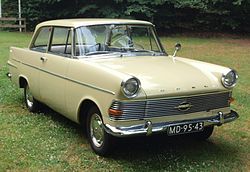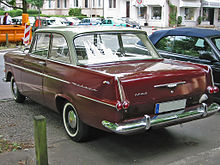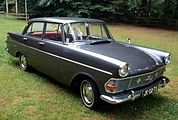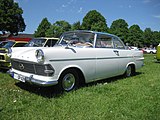Opel Rekord P2
| Opel | |
|---|---|
|
Opel Rekord P2 (1960–1963)
|
|
| Record P2 | |
| Production period: | 1960-1963 |
| Class : | upper middle class |
| Body versions : | Sedan , station wagon , coupé |
| Engines: |
Petrol engines : 1.5-1.7 liters (37-44 kW) |
| Length: | 4515 mm |
| Width: | 1632 mm |
| Height: | 1405-1516 mm |
| Wheelbase : | 2541 mm |
| Empty weight : | 940-1015 kg |
| Previous model | Opel Rekord P1 |
| successor | Opel Rekord A. |
The Opel Rekord P2 is an upper middle class passenger car model that Opel launched on the market in August 1960 as the successor to the Opel Olympia Rekord P (which was subsequently referred to as the Rekord P1 when the P2 was released ). One innovation was the coupé version that was initially built outside of the company and later on in the factory.
Model history
General
The body was redesigned and the panoramic windows - which the "P" stood for in the model name - no longer bent around as far as on the predecessor, which made it easier to get in at the front. Nevertheless, the new model was called "P2".
In terms of technology, Opel was based on its predecessor model in the P2, but the details of the occupant protection were improved. The word “ Olympia ” was still on the glove compartment flap . The interior was modernized. Two-tone upholstery and two-tone paintwork were also available for this model series. When designing the P2, the interior dimensions were first determined before the body was molded. The seating and entry conditions should improve significantly. The panorama windshield was drawn less strongly into the sides in favor of larger doors. The visibility was not impaired by this, the trade press rated the all-round visibility as very good due to the curved front and rear windows. A slight widening of the track by other wheels had a positive effect on the driving behavior, and the suspension comfort was improved. The design of the chassis of the P2 differed significantly from that of the P1: The floor assembly was welded to longitudinal and transverse members, which held the axles and engine. Opel described this construction as self-supporting with a platform frame; it was previously used on the Opel Kapitän P 2.5 and P 2.6.
Available the vehicle was as a two- or four-door notchback sedan , two-door coupe, three-door station wagon caravan and as a three-door van (combi without rear side windows) and was almost three years in the program. The coupé, the roof of which was lower and more sloping at the rear than that of the sedan, was nicknamed the “racing trunk” because of its somewhat unbalanced proportions. Initially, Autenrieth converted limousines into coupés in Darmstadt , from August 1961 the Opel parent plant in Rüsselsheim manufactured the coupé body itself. On request, there were convertible conversions from Autenrieth and the Cologne-based body builder Deutsch . Eight of the 20 convertibles built should still exist (as of 2005).
As in the P1 record, the power source was the in-line four - cylinder engine from the 1937 Opel Olympia. The engine block and cylinder head were made of gray cast iron , and the crankshaft was four-bearing. It was available with 50 PS (37 kW) from 1.5 liters displacement and 55 hp (40 kW) from 1.7 liters. The output of the 1700 L has been increased to 60 hp (44 kW). The Rekord 1500 had a fully synchronized three-speed transmission , the models 1700, 1700 L and the Coupé were available with a four-speed transmission on request. All had steering wheel shifts . The rigid rear axle was driven by a one-piece cardan shaft. All models except the 1700 L with four-speed gearbox could also be equipped with the semi-automatic Saxomat clutch from Fichtel & Sachs , which was called “ Olymat ” at Opel . The semi-automatic transmission consisted of a centrifugal force-controlled starting clutch and a second clutch for changing gears. The second clutch, activated by the negative pressure of the engine, was activated by an electrical contact on the gearshift lever when shifting, eliminating the need for the clutch pedal. The Olymat worked similarly to the automatic clutch “ Hydrak ” in the six-cylinder pontoon Mercedes (W105) with a more comfortable but technically complex hydraulic start-up clutch.
By the end of production in February 1963, a total of 556,691 copies had rolled off the production line. In the following month, the successor Opel Rekord A came onto the market.
Parallel to the P2 there was the P1 until December 1962 as an Opel 1200 with simple equipment, 1.2 l displacement and 40 hp (29 kW) later 46 hp (34 kW) at 4700 rpm or with 1.5 liters and 55 hp ( 40 kW).
Technical specifications
| Technical data Opel Rekord P2 (1960–1963) | |||||
|---|---|---|---|---|---|
| 1200 (1958-1963) | 1500 (1957-1959) | 1500 (1960-1963) | 1700 (1960-1963) | 1700 S (1962-1963) |
|
| Engine: | Four-cylinder - inline engine ( four-stroke - gasoline engine ) | ||||
| Displacement: | 1196 cc | 1488 cc | 1680 cc | ||
| Bore × stroke: | 72 × 74 mm | 80 × 74 mm | 85 × 74 mm | ||
| Performance at 1 / min: |
29 kW (40 hp) 4400 |
33 kW (45 PS) 3900 |
37 kW (50 PS) 4000 |
40 kW (55 PS) 4000 |
44 kW (60 hp) 4100 |
| Max. Torque at 1 / min: |
82 Nm 2500 |
98 Nm 2300 |
106 Nm 2100 |
120 Nm 2100 |
125 Nm 1700-2000 |
| Compression: | 7.5: 1 | 6.9: 1 | 7.25: 1 | 8.0: 1 | |
| Mixture preparation: | An Opel downdraft carburetor (license from the US company Carter Carburetor Co. ) Air funnel 30 mm Ø (1700 S: 36 mm) |
||||
| Valve control: |
Overhead valves , bumpers and rocker arms on the side camshaft , driven by spur gears |
||||
| Cooling: |
Water cooling with pump, thermostatically controlled coolant circuit with expansion material thermostatic valve |
||||
| Transmission: | 3-speed gearbox (from 1960 also 4-speed gearbox), steering wheel shift | ||||
| Front suspension: | individually on double wishbones , coil springs , stabilizer | ||||
| Steering: | Recirculating ball steering , three-part tie rod | ||||
| Rear suspension: | Rigid axle on 2 semi-elliptical leaf springs with 3 (Caravan: 4) spring layers | ||||
| Brakes: | hydraulically operated drum brakes , Ø 200 mm (caravan rear 230 mm) | ||||
| Electrical system: | 6 volts, direct current alternator with charge regulator , battery 77 Ah | ||||
| Body: | Sheet steel, self-supporting | ||||
| Track width front / rear: | 1260/1270 mm (from 1960: 1265/1280 mm) | ||||
| Wheelbase: | 2541 mm | ||||
| Length: | 4433 mm, from 1960 4515 mm | ||||
| Empty weight: | 910–975 kg (caravan: 1000–1015 kg) | ||||
| Top speed: | 119 km / h | 125–128 km / h | 130-132 km / h | 135-140 km / h | |
| 0-100 km / h: | 33 p | 24-27 p | 20-22 p | 20 s | |
| Consumption (liters / 100 km): | 9.0 l normal | 9.5-10.5 l normal | 9.5 l super | ||
literature
- Werner Oswald : German Cars 1945–1975. Motorbuch Verlag, Stuttgart 1975, ISBN 3-87943-391-7 , pp. 88-93.
Web links
- New Objectivity - 50 Years of Opel Rekord P2 from August 28, 2010 on media.gm.com, accessed on October 2, 2014
- Opel Rekord P2
- Description of the Olymat coupling with pictures
- Record P2 forum
- Spherical panorama of the interior of an Opel Rekord P2
- Opel Rekord P2 - the Rüsselsheim line of reason : Articles with historical photos, sound recordings, digitized sales brochures and references
Individual evidence
- ↑ a b Eckhart Bartels, Rainer Manthey: Opel: Vehicle Chronicle Volume 2: 1952–1990. Podszun, Brilon 2012, ISBN 978-3-86133-620-4 , pp. 8/9 and 26.
- ↑ Golden anniversary: The Opel Rekord turns 50 on May 23, 2013 on media.gm.com, accessed on October 2, 2014
- ↑ Archived copy ( memento of the original from November 29, 2014 in the Internet Archive ) Info: The archive link was inserted automatically and has not yet been checked. Please check the original and archive link according to the instructions and then remove this notice.








